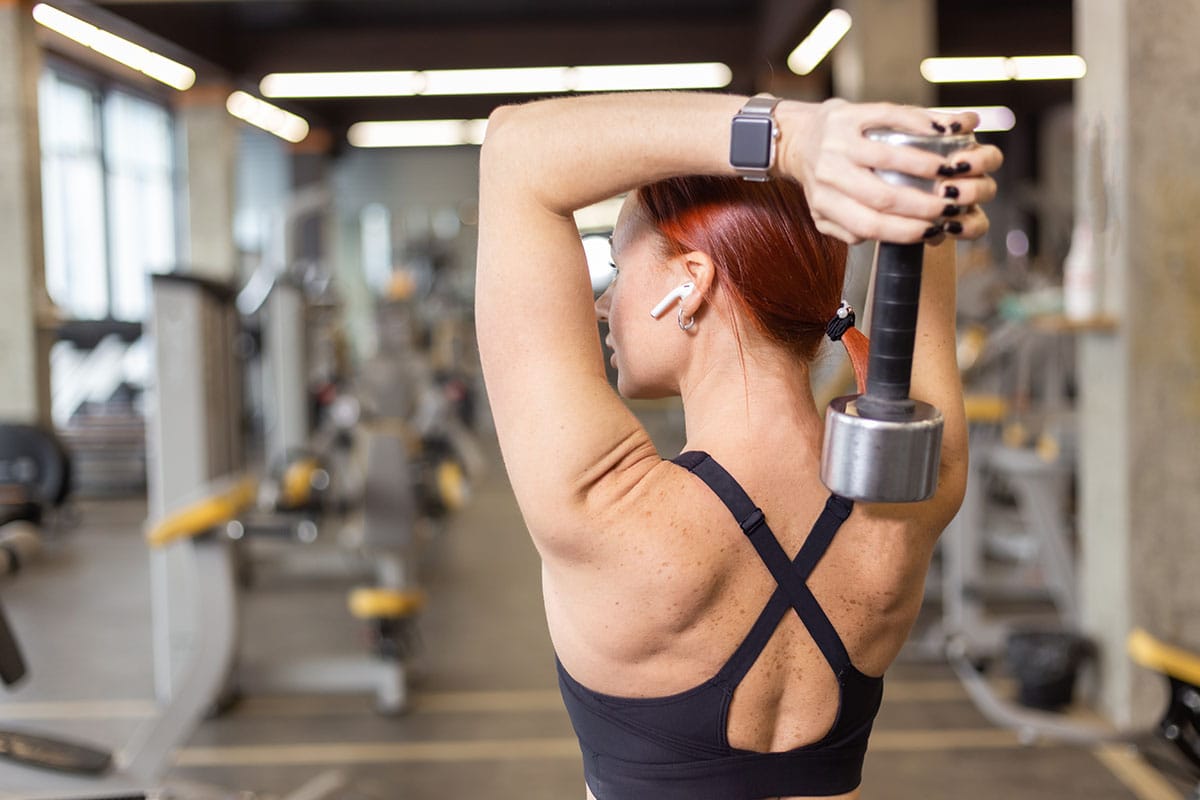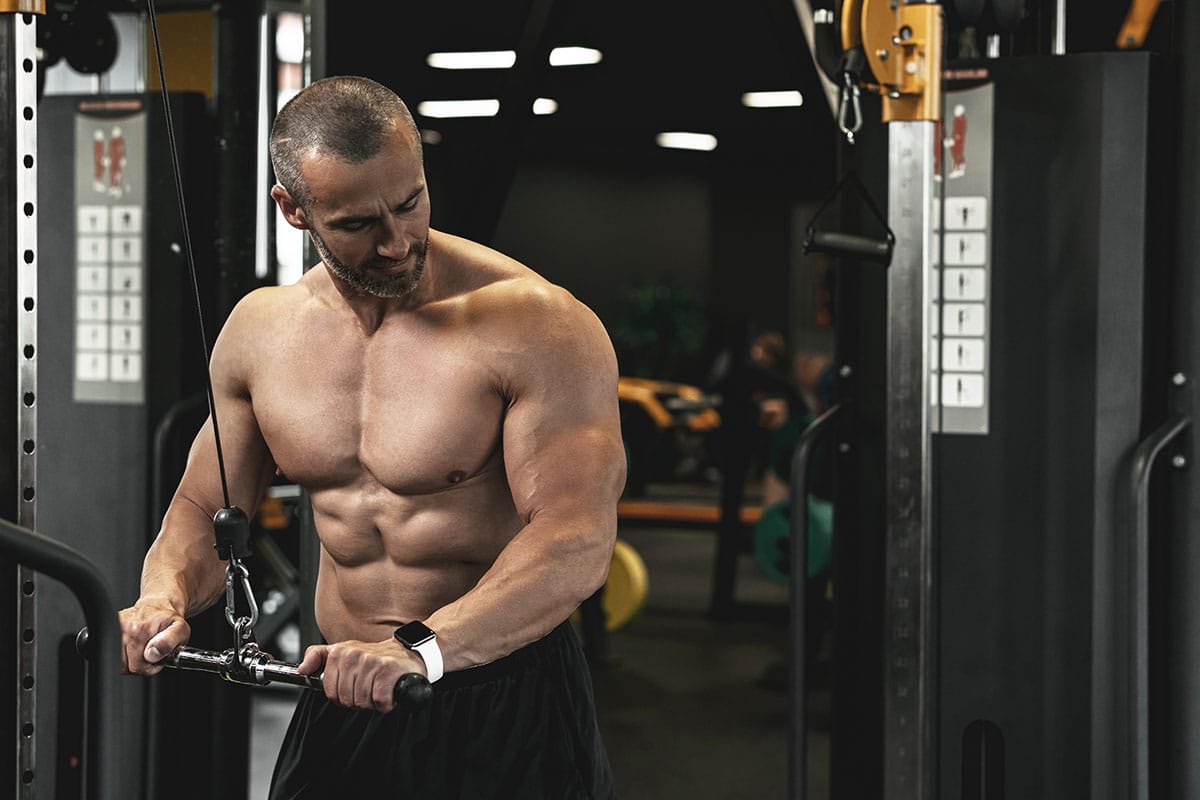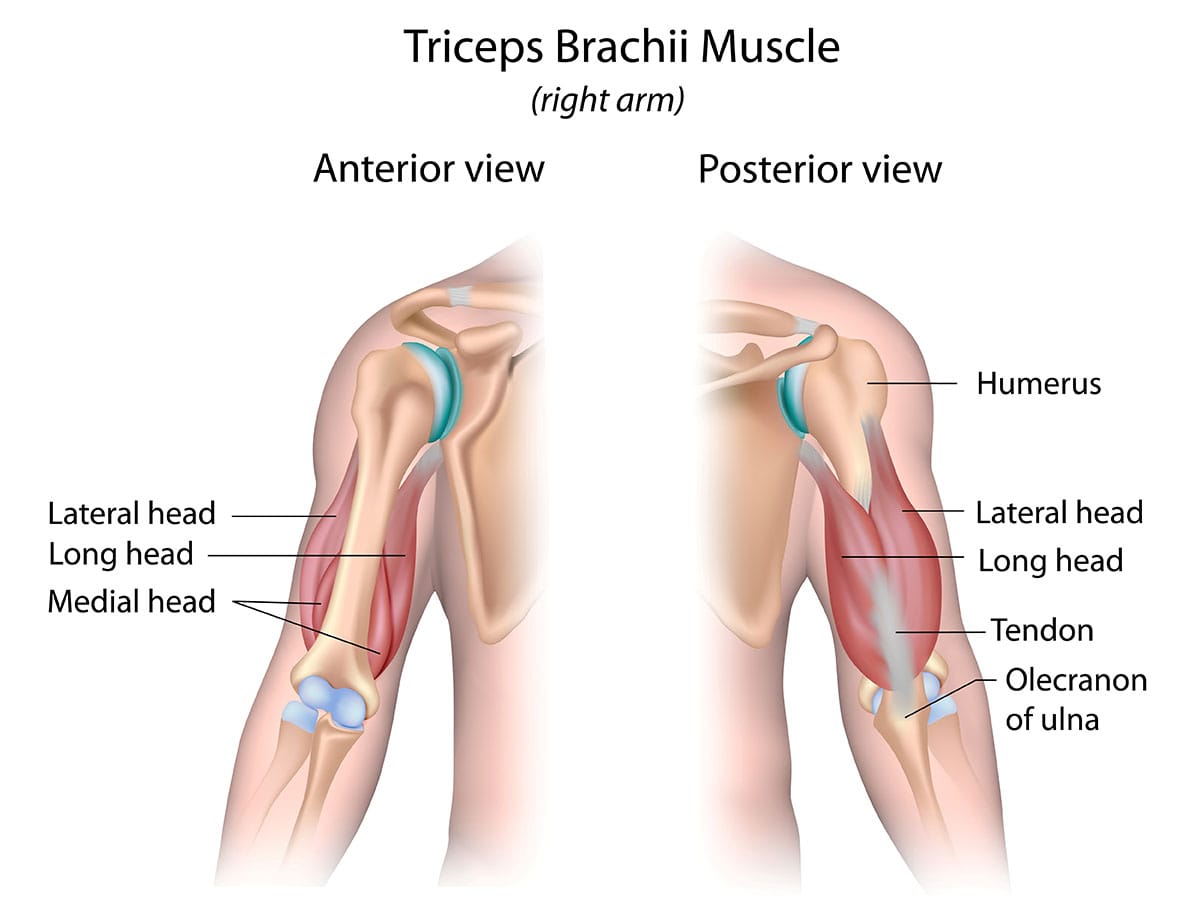Bad Tricep Genetics? Tips to Build Strong & Defined Arms
If your triceps are leaving much to be desired, have you ever looked at the possibility of whether it’s not workout-dependent at all?
It may seem like, try as you might, there’s nothing that’s able to grow your puny triceps.
Could it be your genes that are putting the brakes on your gains?
This article will cover the genetic reason why your triceps may not be as strong, muscular, or defined as you hope and how to remedy this issue. We’ll look at the anatomy of this three-headed muscle and get to know how your triceps operate in the body.
See what physical and genetic characteristics are considered bad vs. good tricep genetics.
Finally, we’ll walk through a few training tips you can use to craft a workout routine to optimize tricep engagement and grow stubborn muscles.
What Makes Tricep Genetics “Bad”?
There are a few key factors to be considered when we talk about “bad tricep genetics.”
Bad tricep genetics refers to the natural structure or shape of your tricep muscles that may make it harder to build size, definition, or symmetry in that area compared to other people.
Genetics influence several factors that affect muscle growth and aesthetics. This can apply to your triceps as well.
Ultimately, there’s no cut-and-dry definition of “bad,” but there are a few characteristics that are considered less-than-optimal in bodybuilding and fitness spheres.
Here are a few noticeable factors that can indicate bad tricep genetics.
Insertion Points
Do you have high or low muscle insertions?
If your triceps have high muscle insertions, meaning the muscles attach higher up on the arm, you may have more tendon length and less muscle belly.
Depending on what look you’re going for, this could be considered “good” or “bad.” High insertions give your muscles more of a “peak” or apex point, so they can look larger at their fullest point.
But because of the shorter attachment point, they may now have the appearance of spanning the full length of your arm,
Muscle Fiber Proportions
You’ve probably heard of slow twitch vs. fast twitch muscle fibers, and everyone’s got a unique proportion of each fiber type.
Muscle fiber composition varies greatly based on your genes. People with more slow-twitch fibers generally have better endurance but lower muscle size. Think about the physique of a long-distance or marathon runner. You often see people who are very lean and athletic but often look very slim or small.
Those with more fast-twitch fibers, on the other hand, typically have better power and capacity for quick acceleration but less endurance. Think of a sprinter.
You’ll often see bulkier athletes with thick thighs and powerful muscles all over. Compared to people with more slow twitch fibers, they have an easier time building muscle mass. If you have more slow twitch muscle fibers, your arms may be strong but look scrawny since you have a harder time bulking or putting on muscle overall.
Tricep Shape
The shape of the triceps, especially your long head (the largest part of the triceps), can vary genetically. Some people naturally have a less full long head.
This gives you a harder time getting that pumped up, full, and rounded appearance in the triceps. As an ideal, a horseshoe shape is considered attractive for your triceps, with a rounded arch that spans the length of your muscle belly.
We tend to see this shape more prominently in people who have good tricep genetics.
Hormones
Your hormones are influenced by your genes and they can play an important role in how your muscles grow.
People with lower testosterone or growth hormone sensitivity can find it harder to build overall muscle mass. This extends to all parts of your body, including your triceps.
Joints and Bone Structure
The structure of your elbows and upper arms can affect how your triceps look and work. For example, if you have long arms, it can take you more effort to build the look of thick triceps since, optically, your arm length will give the appearance of less “bulk.”
Remember, if you like the way your triceps look and find that they’re strong enough to help you lift, twist, and push what you need to, no one can call your arms “bad”!
These are simply standards in the fitness industry and bodybuilding community that apply to whether your triceps would be considered optimal or not.
Exercises for Bad Tricep Genetics
Bearing all the above tips in mind, what exercises are good to counteract bad tricep genetics?
Here are four supercharged moves you can use to strengthen and tone the triceps.
Here are 4 exercises that can help strengthen and build size in small or weak triceps, along with step-by-step instructions:
1. Close-Grip Bench Press

- Set-Up: Lie on a flat bench and grab a loaded barbell with your hands shoulder-width apart.
- Body Position: Plant your feet flat on the floor. Keep your back flat against the bench, and engage your core muscles.
- Action: Lower your barbell down to your chest slowly. Keep your elbows tight to the sides of your body. Bring the bar down until it hovers just above your chest.
- Reverse: Press your bar back up and squeeze your triceps at the top.
- Reps: 3-4 sets X 8-12 reps.
Read more about suicide grip bench press.
2. Overhead Tricep Extension

- Set-Up: Hold a dumbbell, barbell or kettlebell overhead with both hands.
- Body Position: Keep your feet shoulder-width apart. Engage your core and make sure your arms stay extended above your head.
- Action: Slowly and with control, lower your weight behind your head by hinging at the elbows. Your upper arms should stay still during this movement.
- Reverse: Straighten your arms to bring your weight back to the starting position. Focus on feeling a stretch and squeeze in your triceps.
- Reps: 3 sets X 10-12 reps.
3. Tricep Dips

- Set-Up: Hold the edge of a weight bench, chair, dip bars, or other stable surface.
- Body Position: Depending on your set-up, you can cross your legs underneath you (dip bars), extend your legs, and place your heels on the floor or keep your knees bent (this is the easiest variation).
- Action: Bend into your elbows and lower until your elbows come to a 90-degree angle, keeping your back straight.
- Reverse: Push back up, straightening your arms as you squeeze your triceps.
- Reps: 3 sets X 8-10 reps.
4. Tricep Cable Pushdowns

- Set-Up: Attach a straight bar or rope to the high pulley of a cable machine.
- Body Position: Face towards the machine and grab your bar or rope with an overhand grip. Keep your elbows tucked into your sides.
- Action: Push the bar down to extend your arms. Keeping your elbows still and tucked in so you concentrate on using your triceps.
- Reverse: Slowly resist your weight and bring the bar to your starting position.
- Reps: 3-4 sets X 10-15 reps.
Any one of these tricep exercises is a great move to add to your push day workout (triceps, chest, and shoulders).
If you really struggle to build muscle, though, consider adding all or most of these moves in each time you train your triceps.
These exercises effectively target all three heads of the triceps, helping you build strength and size in the muscle group
Tricep Muscle Anatomy

Finally, The triceps brachii is a large muscle located on the back of the upper arm. It plays a crucial role in the movement of the elbow and shoulder joints. Here’s a breakdown of its structure and function:
What Are the 3 Head of the Triceps?
Your triceps have three distinctive heads that come together to form your muscle:
- Long Head:
The long head originates from the infraglenoid tubercle of your scapula (shoulder blade). It extends your arm from your shoulder, keeping the shoulder joint stable.
- Lateral Head:
This head comes from the posterior (back) surface of the humerus (upper arm bone), above the radial groove. It’s most active when you make strong or dynamic elbow extension movements like shoving or lifting objects.
- Medial Head:
The medial originates from the same point as the lateral head. This head of your triep helps with more controlled and small movements of elbow extension, especially low-intensity movement.
All three heads come together to converge into a common tendon that inserts into the olecranon process of the ulna (a bone in the forearm).
What Do Your Triceps Do?
- Elbow Extension: Chiefly, your triceps extend your elbows. When the tricep muscle contracts, it straightens your arm by pulling your forearm backward. Think about any pushing movement you make, like push-ups and you can visualize the work your triceps do.
- Shoulder Stabilization: The long head of your triceps is a major player in keeping your shoulder joint stable when you move your arms. For overhead movements where you lift your arms up, (like an overhead tricep extension exercise), this is particularly relevant.
- Shoulder Extension: The long head also assists when you extend your arms backward from the shoulder joint, working along with muscles like your latissimus dorsi (“lats”).
Any pushing actions like pressing weights up (bench press, shoulder press) or pushing doors open heavily recruit your triceps.
Sports that involve throwing, pushing, or striking, too, like basketball, boxing, or swimming use the triceps to generate power.
The triceps have a muscle agonist—antagonist interaction with your biceps, meaning their muscular functions counteract one another. While you use your biceps, to flex the elbow joints, closing them off, the triceps extend them to reverse the motion that the biceps create.
But if your triceps are bringing you down, how can you work around this muscular pitfall to create balanced arms?
Take a look at a few workarounds for bar tricep genetics.
How to Overcome Bad Tricep Genetics
Now that we know what bad tricep genetics look like, is there a good way to work around them or are you stuck with small arms?
While genetics do play a role, consistent training, working on both compound exercises and tricep isolation exercises, and a solid diet can significantly help you out.
Exercises like skull crushers, tricep pushdowns, and close-grip bench presses can target different heads of the triceps to maximize growth potential.
Here are a few ways you can work around bad tricep genetics:
Overcoming bad tricep genetics can be challenging, but with the right approach, you can still achieve growth and definition. Here are 3 tips to help you maximize your tricep development:
1. Focus on All Three Heads of the Triceps
The triceps consist of three heads: long head, lateral head, and medial head. To build balanced triceps, you need to target all three using the best long head tricep exercises, medial head tricep exercises, and short head tricep exercises.
Pro-Tip: Include a variety of exercises like overhead tricep extensions (long head), tricep pushdowns (lateral head), and close-grip bench presses (overall mass).
2. Progressive Overload
Progressive overload means gradually increasing your weights used, resistance, rep count or some other component of your workouts to continue challenging your muscles to grow.
Over time, you can expect this to result in strength gains and it's a great tool for maximizing muscle hypertrophy (aka, helping your muscles grow!).
Pro-Tip: Increase your weight, rep count, or the intensity of your tricep exercises every couple weeks. This will help keep your muscles adapting and growing.
3. Train Often
If triceps are a weak point, training them more frequently (2-3 times per week) can stimulate additional growth, while allowing enough recovery time between sessions.
Tip: Add tricep-focused exercises into different training days, like pairing them with chest or shoulder workouts for a “push” session.
Remember, the key to growing a muscle group is giving it lots of training volume. By working out the triceps with other muscles, for example, using a 3-day workout split is a great way to increase your training volume.
Try it for yourself and aim to use a combination of these strategies. By structuring your workouts this way, you’ll be able to overcome your genetic limitations (at least in part) and get stronger, more defined triceps.
With these technique tips in mind, which exercises will actually help you build up your triceps?
We have a guide to the four top moves for bad tricep genetics next. Use these moves at least weekly to help grow stronger upper arms!
Big Picture
To sum things up, people with high tricep insertions (muscle attaches closer to your elbows) tend to have a shorter triceps muscle belly. This can make your arms look less full or defined along their whole length, but you may see higher muscle peaks.
Some people may prefer one look to the other, but ultimately, your genes will control how your muscles insert. Furthermore, some people have higher or lower percentages of slow-twitch or fast-twitch muscle fibers, influencing how hard it is for you to build muscle mass (people with more fast-twitch tend to build muscle more easily).
No, you can’t change your genetics, but you can maximize tricep growth with a little strategic training.
Work on a selection of exercises to target all three heads of the triceps, like close-grip bench presses, dips, overhead tricep extensions, and tricep pushdowns.
Keep your diet full of lean protein, make sure you get quality recovery time and keep a log of your tricep gains using the Flex Fitness app. All these tools can help you optimize your triceps growth, regardless of genetic limitations.
Related articles


Get fit with Flex
Build muscle & lose weight fast for free.
Available on iPhone + Apple Watch





